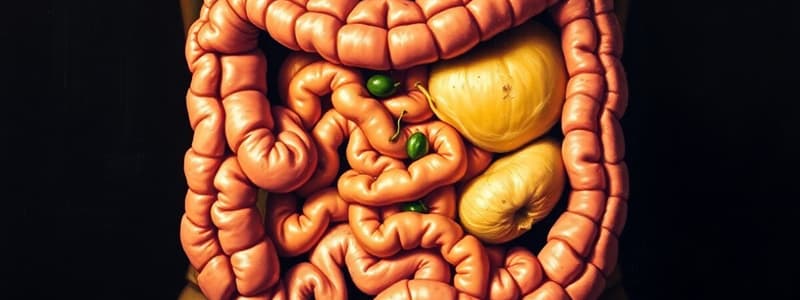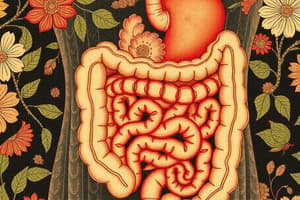Podcast
Questions and Answers
What is the primary role of the GI system?
What is the primary role of the GI system?
- To filter toxins from the blood
- To produce hormones for metabolism
- To break down ingested food into absorbable nutrients (correct)
- To store nutrients for future use
Which of the following is NOT one of the five basic digestive processes?
Which of the following is NOT one of the five basic digestive processes?
- Absorption
- Enzyme activation (correct)
- Motility
- Secretion
What do propulsive movements in the digestive tract accomplish?
What do propulsive movements in the digestive tract accomplish?
- They push contents forward through the digestive tract (correct)
- They stimulate enzyme secretion
- They increase the surface area for digestion
- They compress food to enhance absorption
Which of the following components is transferred into systemic circulation by the GI system?
Which of the following components is transferred into systemic circulation by the GI system?
How do the nutrient molecules in ingested food benefit the body?
How do the nutrient molecules in ingested food benefit the body?
Which enzyme is NOT found in the exocrine secretions of the GI tract?
Which enzyme is NOT found in the exocrine secretions of the GI tract?
What is the primary function of endocrine secretions in the GI system?
What is the primary function of endocrine secretions in the GI system?
Which of the following processes occurs primarily in the small intestine?
Which of the following processes occurs primarily in the small intestine?
What are the absorbable units resulting from the digestion of carbohydrates?
What are the absorbable units resulting from the digestion of carbohydrates?
What does the process of hydrolysis primarily accomplish in digestion?
What does the process of hydrolysis primarily accomplish in digestion?
Which of the following substances is considered an exocrine secretion in the GI tract?
Which of the following substances is considered an exocrine secretion in the GI tract?
Which component is NOT directly involved in the mixing process of food in the GI tract?
Which component is NOT directly involved in the mixing process of food in the GI tract?
What is the role of mucus in the gastrointestinal tract?
What is the role of mucus in the gastrointestinal tract?
What is the primary function of the upper part of the alimentary canal?
What is the primary function of the upper part of the alimentary canal?
Which component is NOT part of the accessory organs and glands?
Which component is NOT part of the accessory organs and glands?
In which part of the alimentary canal do the main digestive and absorptive processes occur?
In which part of the alimentary canal do the main digestive and absorptive processes occur?
What is the main role of the mucosa layer in the wall structure of the alimentary canal?
What is the main role of the mucosa layer in the wall structure of the alimentary canal?
Which section of the large intestine is primarily responsible for waste storage?
Which section of the large intestine is primarily responsible for waste storage?
How long is the alimentary canal approximately?
How long is the alimentary canal approximately?
Which part of the alimentary canal follows the stomach?
Which part of the alimentary canal follows the stomach?
Which structure is considered part of the accessory digestive organs?
Which structure is considered part of the accessory digestive organs?
What is one of the main functions of the large intestine?
What is one of the main functions of the large intestine?
What is the approximate order of sections in the small intestine from start to finish?
What is the approximate order of sections in the small intestine from start to finish?
What is the primary function of the submucosa in the alimentary canal?
What is the primary function of the submucosa in the alimentary canal?
Which two layers of the alimentary canal contain intrinsic nerve plexuses that help regulate gut motility?
Which two layers of the alimentary canal contain intrinsic nerve plexuses that help regulate gut motility?
What type of muscle is primarily found in the muscularis externa of the alimentary canal?
What type of muscle is primarily found in the muscularis externa of the alimentary canal?
Which layer of the alimentary canal is continuous with the mesentery?
Which layer of the alimentary canal is continuous with the mesentery?
What role does the myenteric plexus of Auerbach primarily play in the digestive process?
What role does the myenteric plexus of Auerbach primarily play in the digestive process?
What is the primary function of the serous fluid secreted in the gastrointestinal system?
What is the primary function of the serous fluid secreted in the gastrointestinal system?
Which of the following best describes the role of interstitial cells of Cajal?
Which of the following best describes the role of interstitial cells of Cajal?
What is the role of intrinsic nerve plexuses in the gastrointestinal system?
What is the role of intrinsic nerve plexuses in the gastrointestinal system?
How do extrinsic nerves influence gastrointestinal activity?
How do extrinsic nerves influence gastrointestinal activity?
Which receptors are involved in local sensory responses within the gastrointestinal tract?
Which receptors are involved in local sensory responses within the gastrointestinal tract?
What is the significance of mastication in the digestive process?
What is the significance of mastication in the digestive process?
In the process of deglutition, which stage follows the oropharyngeal phase?
In the process of deglutition, which stage follows the oropharyngeal phase?
What role does saliva play in digestion?
What role does saliva play in digestion?
Which statement accurately reflects the role of gastrointestinal hormones?
Which statement accurately reflects the role of gastrointestinal hormones?
What is the main purpose of the swallowing process?
What is the main purpose of the swallowing process?
Flashcards
What is the GI system?
What is the GI system?
The group of organs responsible for breaking down food into absorbable nutrients and delivering them to the bloodstream.
What does "digestion" mean in the context of the GI system?
What does "digestion" mean in the context of the GI system?
The process of biochemically breaking down ingested food into smaller, simpler nutrient molecules.
What is the purpose of "absorption" in the GI system?
What is the purpose of "absorption" in the GI system?
The transport of digested nutrients, electrolytes, and water from the GI tract into the bloodstream to be used by the body.
What is "motility" in the context of the GI system?
What is "motility" in the context of the GI system?
Signup and view all the flashcards
What are the five basic processes of digestion?
What are the five basic processes of digestion?
Signup and view all the flashcards
Digestion
Digestion
Signup and view all the flashcards
Absorption
Absorption
Signup and view all the flashcards
Mixing movements
Mixing movements
Signup and view all the flashcards
Digestive juices
Digestive juices
Signup and view all the flashcards
Secretions in the GI tract
Secretions in the GI tract
Signup and view all the flashcards
Exocrine secretions
Exocrine secretions
Signup and view all the flashcards
Endocrine secretions
Endocrine secretions
Signup and view all the flashcards
Biochemical breakdown during digestion
Biochemical breakdown during digestion
Signup and view all the flashcards
What is the submucosa?
What is the submucosa?
Signup and view all the flashcards
What are the functions of the submucosa?
What are the functions of the submucosa?
Signup and view all the flashcards
What is the submucosal nerve plexus of Meissner?
What is the submucosal nerve plexus of Meissner?
Signup and view all the flashcards
What is the muscularis externa?
What is the muscularis externa?
Signup and view all the flashcards
What is the myenteric plexus of Auerbach?
What is the myenteric plexus of Auerbach?
Signup and view all the flashcards
What is the alimentary canal?
What is the alimentary canal?
Signup and view all the flashcards
What role do accessory organs play in digestion?
What role do accessory organs play in digestion?
Signup and view all the flashcards
What is the primary function of the upper GI Tract?
What is the primary function of the upper GI Tract?
Signup and view all the flashcards
What is the primary function of the middle GI Tract?
What is the primary function of the middle GI Tract?
Signup and view all the flashcards
What is the primary function of the lower GI Tract?
What is the primary function of the lower GI Tract?
Signup and view all the flashcards
Describe the Mucosa layer in the alimentary canal.
Describe the Mucosa layer in the alimentary canal.
Signup and view all the flashcards
What is the submucosa's role in the alimentary canal?
What is the submucosa's role in the alimentary canal?
Signup and view all the flashcards
Explain the role of the muscularis layer in digestion.
Explain the role of the muscularis layer in digestion.
Signup and view all the flashcards
What is the function of the serosa layer?
What is the function of the serosa layer?
Signup and view all the flashcards
What is the role of the salivary glands?
What is the role of the salivary glands?
Signup and view all the flashcards
Peritoneum
Peritoneum
Signup and view all the flashcards
Serous fluid
Serous fluid
Signup and view all the flashcards
Interstitial cells of Cajal (ICC)
Interstitial cells of Cajal (ICC)
Signup and view all the flashcards
Enteric Nervous System (ENS)
Enteric Nervous System (ENS)
Signup and view all the flashcards
Extrinsic nerves (ANS)
Extrinsic nerves (ANS)
Signup and view all the flashcards
Gastrointestinal hormones
Gastrointestinal hormones
Signup and view all the flashcards
Local sensory receptors
Local sensory receptors
Signup and view all the flashcards
Mastication
Mastication
Signup and view all the flashcards
Deglutition
Deglutition
Signup and view all the flashcards
Oropharyngeal stage of swallowing
Oropharyngeal stage of swallowing
Signup and view all the flashcards
Study Notes
The GI System
- A group of organs working together to break down ingested food into smaller, absorbable nutrient molecules for distribution to all the body's cells.
Main Functions
- Digest or biochemically breaks down ingested food into small, simple nutrient molecules.
- Absorbs and transfers nutrient molecules, electrolytes, and water from ingested food into systemic circulation.
- Makes preformed organic nutrient molecules available to body cells as sources of fuel or energy (building blocks).
Digestive Processes
- 5 basic digestive processes: motility, secretion, digestion, absorption, and storage & elimination of indigestible food.
Motility
- Muscular contractions mix and move digestive tract contents forward.
- Two types:
- Propulsive movements: propel or push contents through the digestive tract.
- Mixing movements: mix food with digestive juices to promote digestion and facilitate absorption of digested food.
Secretion
- Several digestive juices secreted in the GI tract in response to specific neural or hormonal stimulation.
- Consist of water, electrolytes, and specific organic constituents (enzymes, mucus, etc.).
- Include both exocrine and endocrine secretions.
- Exocrine: secreted into the lumen of the GI tract (water, HCl, HCO3-, bile, lipase, pepsin, amylase, trypsin, and histamine).
- Endocrine: secreted into the blood stream (gastrin, secretin, CCK, VIP, and somatostatin).
Digestion
- Biochemical breakdown of complex foodstuffs into smaller, absorbable units (chemical digestion).
- Accomplished by enzyme-mediated hydrolysis.
- Examples:
- Carbohydrates → monosaccharides
- Proteins → amino acids (AA)
- Fats → glycerol & fatty acids
Absorption
- Transfer of small digested units, along with water, vitamins, and electrolytes, from the GI tract into blood or lymph.
- Occurs largely and most completely in the small intestine.
Functional Anatomy of the Gastrointestinal System (Digestive System)
- Gross Structure & Organisation:
- Also called the Gastrointestinal (GI) Tract.
- Comprises 2 main components:
- Alimentary canal: long, continuous hollow tube stretching from the mouth to the anus (~30 feet long).
- Accessory organs & glands: salivary glands, liver, and pancreas.
- Divided into 3 main parts:
- Upper part: mouth, esophagus, and stomach.
- Serves as food intake source and receptacle.
- Site of initial digestive processes.
- Middle part: small intestine (duodenum, jejunum, and ileum).
- Site of main digestive and absorptive processes.
- Lower part: large intestine (cecum, colon, and rectum).
- Serves as storage for and facilitates efficient elimination of waste.
- Upper part: mouth, esophagus, and stomach.
Wall Structure of Alimentary Canal
- Comprises 4 layers:
- Mucosa: innermost, moist, folded lining of epithelial cells, connective tissue, and smooth muscle cells.
- Protective barrier, secretes mucus & digestive enzymes and hormones, absorbs digested nutrients, and undergoes rapid cell division & regeneration.
- Submucosa: dense connective tissue containing blood and lymphatic vessels, lymphoid follicles, and nerve fibres.
- Contains the submucosal nerve plexus of Meissner, provides distensibility and elasticity, and secretes digestive enzymes.
- Muscularis externa: inner layer of circular smooth muscle and outer layer of longitudinal smooth muscle.
- Myenteric plexus of Auerbach lies in between.
- Facilitates mixing and movement of food, and regulates gut motility.
- Serosa: outer connective tissue and epithelial covering.
- Continues with the mesentery.
- Secretes watery, slippery serous fluid for lubrication between digestive organs and viscera.
- Mucosa: innermost, moist, folded lining of epithelial cells, connective tissue, and smooth muscle cells.
Complex Extrinsic & Intrinsic Regulation of Digestive Function
- Mediated via interstitial cells of Cajal (pacemaker cells), Intrinsic nerve plexuses (ENS), Extrinsic nerves (ANS), Gastrointestinal hormones, and Local sensory receptors.
- Interstitial cells of Cajal produce slow-wave potentials stimulating rhythmic electrical activity in GI smooth muscles.
- Intrinsic nerve plexuses regulate GI muscle contraction/relaxation and secretions.
- Extrinsic nerves from the ANS (sympathetic and parasympathetic) stimulate or inhibit GI contraction/relaxation and secretions.
- Gastrointestinal hormones (e.g., gastrin, secretin, CCK) regulate GI contraction and secretion via the blood.
- Local receptors (chemoreceptors, mechanoreceptors, osmoreceptors) produce signals and influence GI motility and secretions.
Swallowing
- Oropharyngeal stage: food is pushed from the mouth into the pharynx.
- Oesophageal stage: The Bolus is passed into the Esophagus and goes to the stomach.
Studying That Suits You
Use AI to generate personalized quizzes and flashcards to suit your learning preferences.





